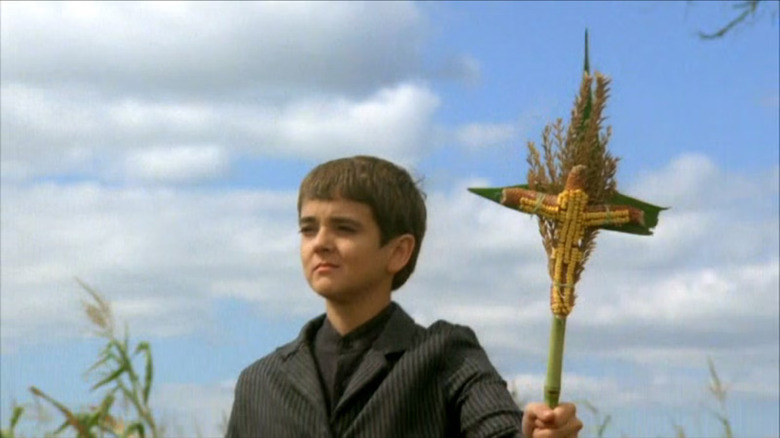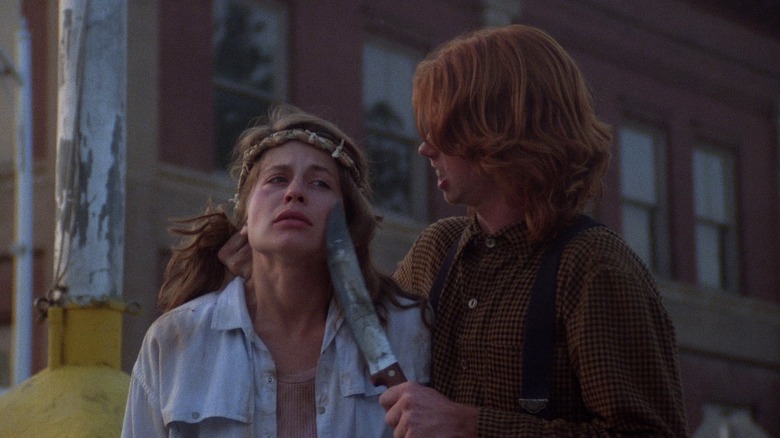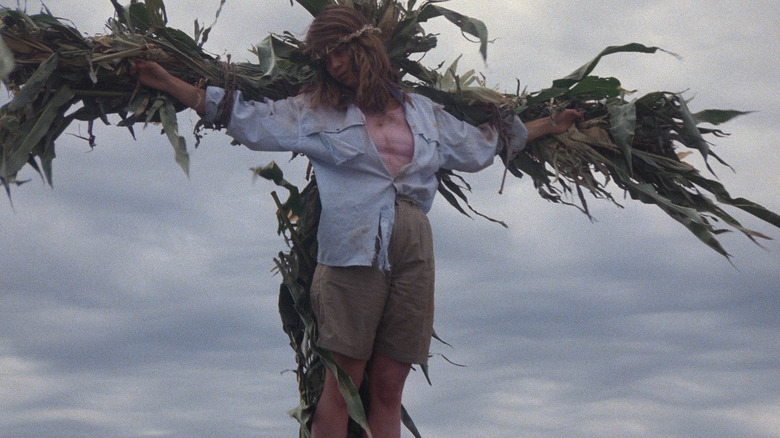Stephen King Exchanged Heated Words With Children Of The Corn's Screenwriter
Stephen King's short story "Children of the Corn" was first published in the March 1977 issue of Penthouse Magazine, and later published in the author's 1978 anthology "Night Shift." The story was about a small town in Nebraska that had been overrun by an eerie cult of killer children. They worship a demonic deity called He Who Walks Behind the Rows and commit regular acts of human sacrifice. A pair of itinerant Californians run afoul of the cult and are killed by their rituals.
As Stephen King stories go, "Corn" is straightforward and simple. It's astonishing to think that it spawned eleven feature films and a short. Fritz Kiersch's 1984 horror film "Children of the Corn" was the second adaptation, coming after the relatively obscure short film "Disciples of the Crow" in 1983. Kiersch's film would see eight direct-ish sequels, and two remakes in 2009 and 2020. Most of the "Corn" films are weird and/or bad, building on an admittedly thin premise of killer kids.
Fun trivia: 2011's "Children of the Corn: Genesis" bafflingly repurposes footage from Michael Bay's "Bad Boys II" for its climax.
George Goldsmith wrote the screenplay to the 1984 version of "Children," and he had the unenviable task of extended King's brief tale into a 92-minute feature. The basic structure was there, but Goldsmith had to add a prologue, a few inner conflicts, several new characters, and a different, more explosive climax in order to make "Corn" into a movie.
The changes Goldsmith made, however, were openly hated by Stephen King. In Francesco Borseti's vital book "It Came from the '80s!: Interviews with 124 Cult Filmmakers" – which was handily quoted in a 2021 article in Cinema Blend – Goldsman recalls butting heads with King, and how King's initial draft of the "Corn" screenplay kinda sucked.
Stephen King's first draft
The story goes that King actually wrote the first draft of the "Children of the Corn" screenplay, just as he had done for earlier adaptations of his work like "Cujo," and "The Dead Zone," both from 1983. In all cases, King's screenplays were rejected in favor of more cinematic alterations. King's screenplay for "Children of the Corn" was, according to Goldsmith, "not cinematic at all." In King's draft, an inordinate amount of time was spent with Burt and Vicky (Peter Horton and Linda Hamilton), the itinerant Californians. Over a half hour of the movie was meant to be scenes of them conversing and bickering in the car. Goldsmith understood that bloodthirsty film audiences would want to get to the mayhem a little more quickly than that.
Goldsmith was brought in to write a better script, and transformed "Corn" into an actual movie. One can argue as to the quality of the finished product, but one can at least admit that it functions perfectly well as a feature film, with a typically cinematic beginning-middle-and-end. When King read Goldman's draft, however, he needed to make an angry phone call. Goldman remembered the phone call well, saying:
"[The story editor] liked my ideas, but Stephen King was Stephen King. And so we had a conference call, the three of us, which Stephen opened up by informing me I did not understand horror. And I countered that he did not understand cinema: horror and fiction are internalized, just like his script. Cinema is external: visual, auditory, a more sensory experience."
It's a fair point, especially if King's original script was meant to have 30 minutes of buildup before any horror took place.
Stephen King's shaky understanding of cinema
By 1984, six major motion pictures had been adapted from King's stories: "Carrie," "The Shining," "Cujo," "The Dead Zone," "Creepshow," and "Christine." King, one might infer, knew a little bit about cinema. But if his scripts were always turned down, King clearly didn't understand how cinema was supposed to work. One might recall that King objected to the changes Stanley Kubrick made to "The Shining" when he adapted it to film. Because "The Shining" is so good, however, one might question if King was being touchy about his novel (which is his right as the author), or if he didn't understand that the changes were irrelevant in the face of how powerful the final film was.
Goldsmith added to King's story a pair of child protagonists that would help the passing Californian adults into the world of the Corn Cult. He also incorporated a chilling prologue wherein all the kids of Gatlin, Nebraska systematically slaughter all the adults. The original story ended with the adult characters getting killed, one of them at the hands of the mysterious He Who Walks Behind the Rows himself. The film ends much more positively with the adults setting the cornfields on fire, and fleeing with their lives intact and smiles on their faces.
One might understand why King didn't like the happy ending. He wrote "Children of the Corn" in the 1970s, and may have been influenced by the low-rent, bleak horror films that were in vogue at the time, like "The Texas Chain Saw Massacre" and "The Last House on the Left."
Would King's script have made "Children of the Corn" better? No one can say. All we know is the version we got was a big enough hit to spawn a series of endless sequels.


